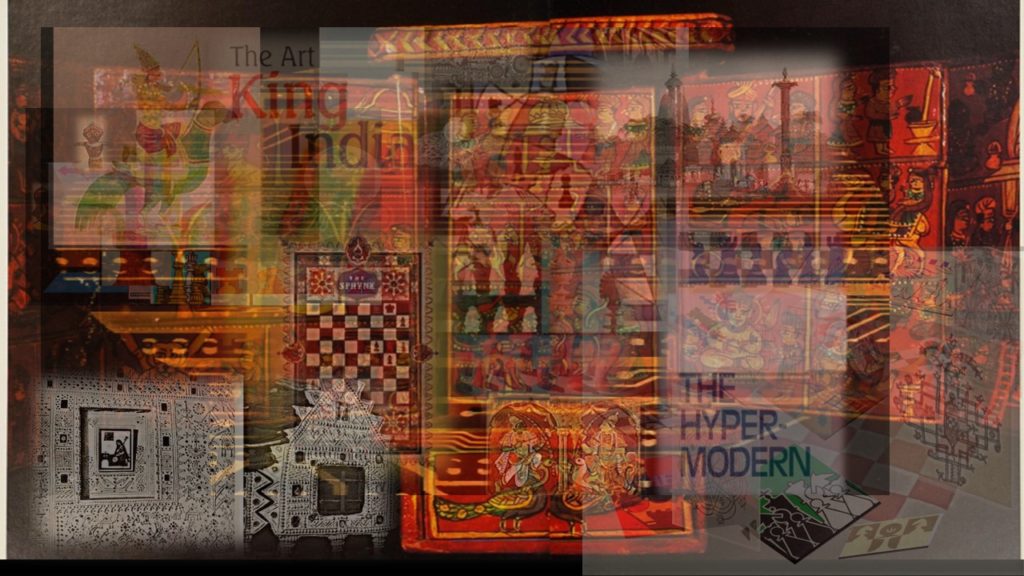In chess, there are 8 major pieces, 8 pawns for each player making 16 pieces each and 32 pieces in all. It is played on an 8×8 square, which makes a board of 64 squares. Therefore the number structure of chess is 8, 16, 32 and 64.
In chess history the game has been associated with allegories in European literature. An early chess allegory, a French work dates around the time of Charles V in France in the late 1300’s, Les Eschez d’Amours, was the work of an anonymous author and was later associated with Evrard de Conty as he copied a portion of it, usually know by the name of Les Echecs Amoureux and which was added some gorgeous art too. For many years Evrard was mistakenly considered the author as his was the main and sometimes the only access people had to the poem. Furthermore, this version of Conty, it finds its way as part-source of Lydgate’s Reason and Sensuality in a few decades after, in which he improvises on it on a part of its beginning. Lydgates’s Reson and Sensuallyte is an important early classic of English literature. This chess allegory associates chess with Cupid, strange as it sounds. It has to be mentioned though that if one has approached the large poetic epic through Evrard, one would think it is a positive portrayal of chess and Cupid allegory. But the more fuller and original version tells a different story in all, as its rather a warning against the cupidity of chess ultimately. Anyhow it contains a description of a chess board in a garden wherein the central character plays chess to attain a lover which is rich in symbols for each piece being a certain quality of the game of love and associated with a precious jewel or gold or silver. As the lover approaches the garden, he encounters various Grecian-Romano gods and goddesses. I will detail this in another post.
Also in early chess allegory tradition in Europe, in Valencian Spain, we find the poem Scachs d’amor, written by Francesc de Castellvi, Bernat Fenollar, and Narcis Vinyoles towards the end of the 1400s and which has a positive appraisal of chess and amor unlike the Les Eschez d’ Amours. The poem has Venus playing Mars and with Mercury as commenting on the game, with Castellvi as the player with the red pieces playing Mars, Vinyoles playing black as Venus with green pieces and Fenollar as Mercury the commentator. Cupid is traditionally associated with Venus but does not appear directly in the game except in its title and in the overarching concept within it, namely Amor. I wont get into the details here except to say its not the first time chess is associated with Amor in the Valencian chess and literary circles as previously Repeticion de Amores y Arte de Ajedrez con 150 Juegos de Partido (“Repetition of Love and the Art of Playing Chess with 150 game problems.”) published in Salamanca in 1497 by Luis Ramirez de Lucena which too is like the poem, Scahs d’amour also of significance as the first writing detailing the rules of chess as we now know them, the modern game, as the rules have slightly changed along the way since its migration into Europe and how it was played in Persia. Luis Ramirez de Lucena’s book is in two parts, the chess games problem positions from various games. Some suggest a link to the 150 beads of a rosary of prayer to the Virgin Mary. The other section which is a treatise of the authors amorous exploits and musings on amour strange as it sounds. Its not the only time a game between the gods appears in early chess allegory literature too, as there is the Scacchia Ludus by Hieronymous Vida in Italy in the 1500s whose poem details a game between Apollo and Mercury in the presence of other gods. It was this Renaissance poet who was the first to intuit a chess goddess called Caissa, a fictional Thracian dryad who was expanded on the 1700s by the poet and Orientalist with knowledge of Indian traditions, William Jones in his Caissa or The Game at Chess, who has Mars playing chess to win the hand of the goddess Caissa hence an amor theme therein. I shall further expand of these instances in another place in more detail.
Elsewhere chess appears in the songs of the Troubadours associated with amor. Amor is a more abstract of that which Cupid embodies, as Amor which is the Latin term for Eros also in the abstract rather than as Eros the Greek deity character form and Eros as deity character form in Latin is the deity/character/form Cupid. Again details of this elsewhere on this blog in time.
Another place chess allegory arises is in Grail literature where it shows up here and there and in its most richest form in the Dutch Gawaine romance Walewein, where it is clearly associated with with a quest which involves a visit to the Kingdom of Love of King Amoraen, India, on a quest to retrieve a magical chessboard for King Arthur. Again, I shall explore this elsewhere.
Thus chess ties up in the early bedrocks of European modern literature alongside of Cupid/Eros/Amor. I am not getting into details here as I wish to instead first point towards the land of India, where the ancient Greek Eros direct equivalent, Kamadeva is found as according to one version of chess history, chess originated in India too, reaching from there Persia then into Arabia and then Europe. Although its not a fixed fact and there have other theories suggesting chess originated in Persia, then went into India and Arabia simultaneously first before Europe, or that it was first China, then Persia, then into India and Arabia then into Europe. I will not get into this here either. But India is before Europe, and is in there, and so it is also here. So let us hone into Cupid resonant regions therein India. Mainly starting with the Radha Krishna traditions, which like the Troubadours and Cupid-Eros/Amor, are love traditions and let us see the number structure upon which chess is framed first.
The devotional tradition of Radha Krishna, is a devotional, theistic, esoteric, and philosophical tradition of love, one of India’s mainstream branches of art, drama, dance, music, literature, poetry, and song. The time it arose in the conscious minds and hearts of the popular people was also the times of the arising of the early western literary tradition too, that of love chess and the Troubadours. Its spiritual practice is the singing, dancing and chanting the Holy Names of God-Krishna in service towards Him in various experiential states of ecstasy. For many they love Krishna not because He is taught as being God, but simply for who he is. He is most certainly God for certain poets, for others he is the inner male principle. The number pattern in chess is symmetrical and identical to the main number structure found within the traditions of Krishna which are traditions which are quintessential perfections of realizations within Vishnu traditions, of Vishnu’s essence and sweetness. This number structure can also be found throughout India’s main spiritual traditions in Buddhism, Jainism, Shaivism, Shaktism, Taoism and others.
In the Vaishnava Krishna branches these numbers are interesting as they deal with love, so as in love chess, also in Radha Krishna bhakti traditions, 8,16,32 and 64 resonate on a string and reed of love. Cupid or Kamadeva also the deity of love, is so akin and inter-weaved with the Krishna poetic traditions (as both share similar terms and categories in Sanskrit with each other interchangeably and are associated with love). Kamadev is usually playing a subordinate to Krishna and whose earlier lost tradition is preserved somewhat inside the Krishna branches more voluminously. Kamadeva has his mandala (sacred pattern) also of chess number as many Indian deities do. The chess number 16 in the traditions of Purusottama Jagannatha of Jagannatha Puri in Orissa, is one where Kamadeva is playing the role of being subordinate to Krishna, as Krishna’s son Pradyumna, or sometimes we can see him those traditions as an aspect of Krishna directly too, which is an unusual feature, possibly not found elsewhere in Indian traditions. Of course the relationship between these two are one also of one tradition incorporating another into its ranks, but it is in one sense a play and lila, on the stage of love Divine.
We see that in a sense the Cupid of the west has traveled east and vice versa as we don’t know who came first the ancient Greek Eros or Kamadeva but their iconography and what they represent is identical in many places so we can assume they are one and the same . When in the east he hangs around within the branches of the Krishna tree which is the tree most resonant too, being a tree of love, and they both have a certain specific relationship within categories of 8, 16, 32 and 64 as we shall see.
The Chaitanyaite Krishna traditions of West Bengal have at their central nexus of places, Jagannatha-Puri in Orissa, and after their establishment there (wherein the Kamadev-Krishna traditions existed we are about to delve into) from there they set off to excavate forest land to recreate the rustic paradise of Krishna at the ancient place of Vrindavana, re-establishing it and in some cases it is said to have been rebuilding prexisting temples. The chiefs of these Chaitanya Krishnaites also known as Gaudiyas, were called the various Goswami representatives of Chaitanya, usually numbered six, although there is a seventh whose popularity in the tradition was eclipsed, called Narayana Bhatta. They were the ones who brought the teachings of Chaitanya into the Brahmin fold. I shall not get into details here.
Chaitanya was considered a golden incarnation of Krishna, and he appeared in Bengal, around the time which the alchemical, hermetical and kabalistic traditions as found hidden in tarot card art (which is an artistic card gaming tradition which has sixteen gods at its heart- hence chess number again) and literature, flowered during the Renaissance. The connection between Tarot and chess is for another post. In the west, the humanist Renaissance was a kind of slight separation from the yoke of mind tied to Roman Church and was where enlightened humanism, Greek and Roman paganism, Greco-Egyptian Hermetica, Arabian Alchemy, Jewish Kabbalah, were all set in a Catholic Christian ambience and progress, which sought to be somewhat free from Church control to various degrees due to families of various statuses of wealth and privilege who could afford to do so. At this time in Bengal, Krishna was incarnating as the Golden Purusha (an earlier conception actually in Indian traditions) and was brought to Puri, as Chaitanya- who was in his youth called Nimai Pandit, later on Mahaprabhu-Gauranga (along with his other name Chaitanya). To some he must have seen to enshrine within and embody the traditions of an earlier golden Vedic purusha and the Vedic conceptions of Chaitanya being ‘life force’. At this time he took the Krishna traditions onto a new plateau which was richly detailed and became widespread and a major river flourishing actually today, all a round the world, with hundreds and hundreds of temples, deities, texts and everything else. Chess expanded also around the world hugely popular, perhaps there is something popular about 8, 16, 32 and 64 and love.

